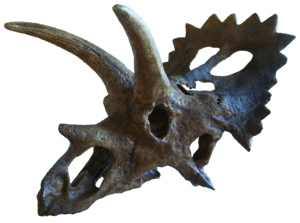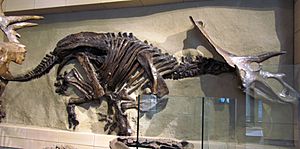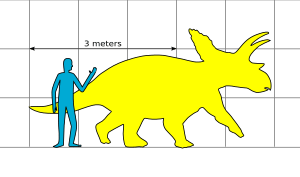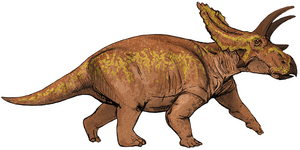Anchiceratops facts for kids
Quick facts for kids Anchiceratops |
|
|---|---|
 |
|
| Skull cast of TMP 1983.001.0001, Geological Museum (Copenhagen) | |
| Scientific classification |
|
| Kingdom: | Animalia |
| Phylum: | Chordata |
| Clade: | Dinosauria |
| Order: | †Ornithischia |
| Family: | †Ceratopsidae |
| Subfamily: | †Chasmosaurinae |
| Genus: | †Anchiceratops Brown, 1914 |
| Type species | |
| †Anchiceratops ornatus Brown, 1914
|
|
| Synonyms | |
|
Anchiceratops longirostris |
|
Anchiceratops was a type of dinosaur that ate only plants. It had a big frill at the back of its head. It also had three horns on its face. Two long horns were above its eyes, and a shorter one was on its nose.
This dinosaur looked a lot like Triceratops, which also had these features. Anchiceratops fossils were found in the Horseshoe Canyon Formation. This is a famous fossil site in Alberta, Canada. There is only one known species of Anchiceratops, called A. ornatus.
Contents
Discovering Anchiceratops
The first Anchiceratops skulls were found in 1912. A famous dinosaur hunter named Barnum Brown discovered them. Two years later, in 1914, he gave them the name Anchiceratops ornatus.
The name Anchiceratops means "almost Ceratops". The word ornatus means "ornate" or "fancy." In 1924, another scientist, C. M. Sternberg, found a different skull. It was smaller and had a long beak.
Sternberg named this new find A. longirostris in 1929. This name means "long snout." However, later studies in 1990 suggested something interesting. Scientists like Leham, Dodson, and Currie thought A. longirostris was actually just a female A. ornatus.
In 1925, Sternberg found a skeleton without a head. He thought it might belong to Anchiceratops. But it could also be from a different dinosaur called Arrhinoceratops. Or it might even be a completely new type of dinosaur. Other Anchiceratops skulls have been found, but they haven't been fully studied yet.
What Anchiceratops Looked Like
Anchiceratops was a big dinosaur. It could grow to be about 4.5 meters (15 feet) long. It weighed around 1.5 tonnes (about 3,300 pounds). That's like a small car!
If the headless skeleton found by Sternberg was indeed Anchiceratops, it would have been a bit smaller. It would be about 4.3 meters (14 feet) long and weigh 1.2 tonnes (about 2,600 pounds).
This dinosaur had a short horn on its nose that pointed forward. The horns above its eyes, called brow horns, were long. They curved slightly and pointed a bit to the side. The frill at the back of its head was narrow. It had many small horn-like bumps along its edge. This frill did not stick up very high. Some Anchiceratops fossils show a very long snout.
The skeleton that might belong to Anchiceratops was a bit unusual. It was smaller than most other dinosaurs in its family group. It had a long neck and strong front legs. But its tail was shorter than expected. It had only 38 tail bones, while most related dinosaurs had about 45. Its thigh bone was 74 centimeters long, and its shin bone was 51.5 centimeters long.
Dinosaur Family Tree
Scientists group dinosaurs into families based on how they are related. Anchiceratops belongs to a group called Chasmosaurinae. This group includes many horned dinosaurs.
Here is how Scott Sampson classified Anchiceratops in 2010. This family tree shows how different horned dinosaurs are connected:
|
||||||||||||||||||||||||||||||||||||||||||||||||||||||||||||||||||||||||||||||||||||||||||||||||||||||||||
Where Anchiceratops Lived
Anchiceratops lived in an area known as the Horseshoe Canyon Formation. This was during the Late Cretaceous period. Other horned dinosaurs, like Arrhinoceratops, might have lived there too.
When Anchiceratops was alive, the Horseshoe Canyon Formation was a big floodplain. It had many forests and marshy areas. It seems Anchiceratops preferred these wet, marshy places. This is different from some other horned dinosaurs that liked drier areas.
Images for kids
See also
 In Spanish: Anchiceratops ornatus para niños
In Spanish: Anchiceratops ornatus para niños








